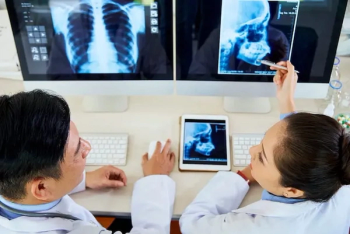Whole Breast Ultrasound Screening: Is There Adequate Utilization in Patients at Higher Risk for Breast Cancer?
In a new study involving over 400,000 women, researchers found that ultrasound screening was performed for 95.3 percent of women with dense breasts but only 21.7 percent of women with a first-degree family history of breast cancer.
New research suggests that whole breast ultrasound screening is not adequately utilized for patients with elevated risks for breast cancer.
For the study, recently published in
The researchers found that 95.3 percent of ultrasound screening exams were performed for women with dense breasts. However, ultrasound screening exams were only performed 43.7 percent of the time for overweight or obese women, 24.3 percent of the time for those who had a prior diagnosis of benign breast disease, and in 21.7 percent of women who had a first-degree family history of breast cancer, according to the study.1
For women between the ages of 35 to 74 with intermediate BCSC five-year invasive breast cancer risk, 27.2 percent had screening ultrasound exams and 19.6 percent only had mammography exams, according to the study. Among women had had high or very high BCSC five-year invasive breast cancer risk, the study authors noted that 18.1 percent had ultrasound screening and 9.5 percent only had mammography exams.1
“Overall, our findings indicate strong selection of women for ultrasound screening based on breast density alone and moderate selection based on other breast cancer risk factors, corresponding to a wide distribution in risk of mammography screening failure among women undergoing breast ultrasound screening,” wrote lead study author Brian L. Sprague, Ph.D., who is affiliated with the Departments of Radiology and Surgery at the University of Vermont Cancer Center in Burlington, Vermont, and colleagues.
Despite recent research that has demonstrated the benefits of supplemental ultrasound in improving cancer detection rates and reducing interval cancer rates, Sprague and colleagues noted low usage of ultrasound screening in their study.1-3 The ratio of ultrasound screening was one per 22 mammography-only screening exams for the overall study cohort and one per 10 mammography-only screening exams among women with dense breasts, according to the study authors.1
Noting a lack of consensus guidelines on supplemental ultrasound screening for women at risk of breast cancer, the study authors emphasized the need for further research to ensure appropriate use of screening ultrasound.
“In our study, mammography failure risk varied widely among women undergoing breast ultrasound screening,” added Sprague and colleagues. “Approximately one-half of ultrasound screening examinations occurred among women with dense breasts and low or average breast cancer risk who are not at high risk of screening failures.”
In regard to study limitations, the authors acknowledged the selection of three registries from the BCSC that had several facilities offering screening ultrasound, and noted this may have contributed to the study’s higher rate of ultrasound screening in comparison to that of other BCSC registries. The researchers conceded the study did not assess frequency of high-penetrance genetic mutations of breast cancer nor did they ascertain the use of ultrasound based on other risk models for assessing breast cancer risk.
References
1. Sprague BL, Ichikawa L, Eavey J, et al. Breast cancer risk characteristics of women undergoing whole-breast ultrasound screening versus mammography alone. Cancer. 2023 Jun 12. doi: 10.1002.cncr.34768. Online ahead of print.
2. Vourtsis A, Berg WA. Breast density implications and supplemental screening. Eur Radiol. 2019;29(4):1762-1777.
3. Harada-Shoji N, Suzuki A, Ishida T, et al. Evaluation of adjunctive ultrasonography for breast cancer detection among women aged 40-49 years with varying breast density undergoing screening mammography: a secondary analysis of a randomized clinical trial. JAMA Netw Open. 2021;4(8):e2121505.
Newsletter
Stay at the forefront of radiology with the Diagnostic Imaging newsletter, delivering the latest news, clinical insights, and imaging advancements for today’s radiologists.





